The Your Windows is infected with (3) Viruses! is just one of the many pages of the so-called misleading ‘ad’ type. It’s created to trick your into installing an questionable software or force you into calling a fake Microsoft or Google support service. If the Firefox, Chrome, Internet Explorer and MS Edge automatically reroutes to the “Your Windows is infected” scam then it could mean that your web browser has been affected by the obnoxious malicious software from the adware family. The adware is made in order to display third-party ads to the user without asking his permission. The ad supported software takes control of all your typical web-browsers and redirects them to unwanted websites like these “Your Windows is infected” alerts every time you browse the Net.

The “Your Windows is infected” warnings are misleading advertising
The full text of the misleading advertising is:
Your Windows is infected with (3) Viruses! Your Windows is infected with (3) Viruses. The pre-scan found traces of (2) malware and (1) spyware. System damage: 28.1% - IMMEDIATE REMOVAL REQUIRED! The removal of (3) Viruses is required immediately to prevent further system damage, loss of Apps, Photos or other files. Traces of (1) Spyware were found on your computer. Personal and banking information are at risk. Step 1: Click on the "Proceed" button to check your computer for viruses.
It is likely that you might be worried with the adware which causes misleading “Your Windows is infected” pop up on your internet browser. You should not disregard this unwanted software. The adware might not only show annoying advertisements, but redirect your web browser to misleading pages. What is more, the adware can analyze your surfing, and gain access to your personal information and, afterwards, can share it with third-parties. Thus, there are more than enough reasons to delete “Your Windows is infected” pop-up scam from your machine.
Most often, the adware affects the most common web-browsers such as the Firefox, Chrome, MS Edge and Internet Explorer. But such the malicious software as well may hijack another web browsers by changing its shortcuts (adding an argument like ‘http://site.address’ into Target field of a internet browser’s shortcut). So every time you start the web-browser, it’ll redirect to the undesired “Your Windows is infected” page. Even if you setup a new home page, an intrusive website will be the first thing you see when you run the Internet Explorer, Mozilla Firefox, Microsoft Edge and Chrome.
Instructions that is shown below, will help you to clean your system from the adware as well as remove “Your Windows is infected” annoying pop-ups from the Firefox, Microsoft Edge, Google Chrome and Internet Explorer and other internet browsers.
Remove “Your Windows is infected” pop-up warnings
As with deleting adware, malware or potentially unwanted programs, there are few steps you may do. We recommend trying them all. If you do only one part of the tutorial, then it should be run malicious software removal tool, because it should remove adware and block any further infection. But to completely remove “Your Windows is infected” pop-up scam you’ll have to at least reset your web-browser settings like newtab, default search provider and homepage to default state, disinfect PC’s browsers shortcuts, delete all unwanted and suspicious apps, and delete adware with malicious software removal tools. Read this manual carefully, bookmark or print it, because you may need to exit your web browser or restart your machine.
To remove “Your Windows is infected”, complete the following steps:
- How to delete “Your Windows is infected” pop up warnings without any software
- Uninstall ad-supported software through the MS Windows Control Panel
- Get rid of unwanted Scheduled Tasks
- Remove “Your Windows is infected” popup from Google Chrome
- Get rid of “Your Windows is infected” popup from Mozilla Firefox
- Get rid of “Your Windows is infected” pop up scam from Internet Explorer
- Clean up the web browsers shortcuts that have been affected by adware
- Remove “Your Windows is infected” pop up warnings with free programs
- Block “Your Windows is infected” pop up warnings and other unwanted webpages
- How to “Your Windows is infected” popup get installed onto personal computer
- To sum up
How to delete “Your Windows is infected” pop up warnings without any software
The useful removal guide for the “Your Windows is infected” fake alerts. The detailed procedure can be followed by anyone as it really does take you step-by-step. If you follow this process to remove “Your Windows is infected” fake alerts let us know how you managed by sending us your comments please.
Uninstall ad-supported software through the MS Windows Control Panel
We recommend that you begin the PC cleaning process by checking the list of installed apps and uninstall all unknown or suspicious software. This is a very important step, as mentioned above, very often the malicious programs such as ad supported software and hijackers may be bundled with freeware. Uninstall the unwanted software can delete the annoying advertisements or browser redirect.
- If you are using Windows 8, 8.1 or 10 then click Windows button, next press Search. Type “Control panel”and press Enter.
- If you are using Windows XP, Vista, 7, then press “Start” button and click “Control Panel”.
- It will open the Windows Control Panel.
- Further, click “Uninstall a program” under Programs category.
- It will show a list of all software installed on the machine.
- Scroll through the all list, and uninstall questionable and unknown apps. To quickly find the latest installed programs, we recommend sort applications by date.
See more details in the video instructions below.
Get rid of unwanted Scheduled Tasks
Once installed, the ad supported software can add a task in to the Windows Task Scheduler Library. Due to this, every time when you start your PC system, it will show “Your Windows is infected” annoying web site. So, you need to check the Task Scheduler Library and remove all malicious tasks which have been created by adware.
Press Windows and R keys on the keyboard together. This shows a dialog box that called Run. In the text field, type “taskschd.msc” (without the quotes) and click OK. Task Scheduler window opens. In the left-hand side, click “Task Scheduler Library”, like below.
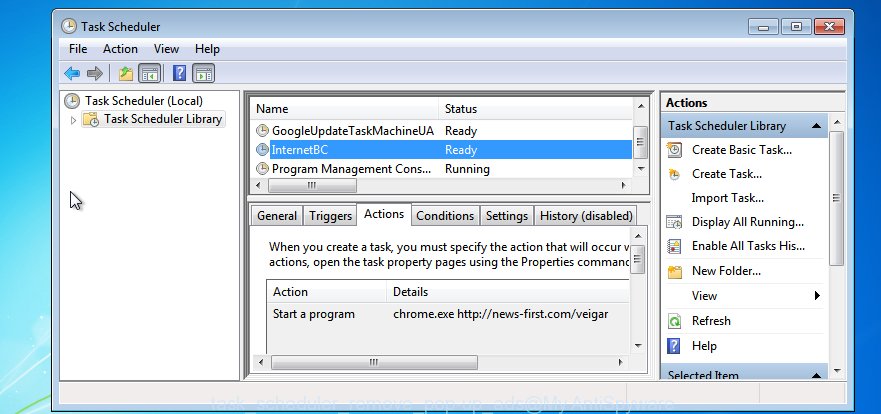
Task scheduler
In the middle part you will see a list of installed tasks. Please select the first task, its properties will be display just below automatically. Next, click the Actions tab. Pay attention to that it launches on your machine. Found something like “explorer.exe http://site.address” or “chrome.exe http://site.address”, then remove this malicious task. If you are not sure that executes the task, check it through a search engine. If it is a component of the adware, then this task also should be removed.
Having defined the task that you want to remove, then press on it with the right mouse button and select Delete as shown in the figure below.

Delete a task
Repeat this step, if you have found a few tasks that have been created by ‘ad-supported’ program. Once is finished, close the Task Scheduler window.
Remove “Your Windows is infected” popup from Google Chrome
Use the Reset web browser utility of the Google Chrome to reset all its settings such as search engine by default, newtab page and home page to original defaults. This is a very useful utility to use, in the case of browser redirects to undesired ad websites like “Your Windows is infected”.

- First start the Chrome and click Menu button (small button in the form of three dots).
- It will show the Google Chrome main menu. Choose More Tools, then click Extensions.
- You’ll see the list of installed extensions. If the list has the extension labeled with “Installed by enterprise policy” or “Installed by your administrator”, then complete the following instructions: Remove Chrome extensions installed by enterprise policy.
- Now open the Google Chrome menu once again, press the “Settings” menu.
- You will see the Chrome’s settings page. Scroll down and press “Advanced” link.
- Scroll down again and click the “Reset” button.
- The Google Chrome will display the reset profile settings page as on the image above.
- Next click the “Reset” button.
- Once this process is complete, your browser’s start page, search engine and newtab will be restored to their original defaults.
- To learn more, read the post How to reset Chrome settings to default.
Get rid of “Your Windows is infected” popup from Mozilla Firefox
If the Firefox web browser is rerouted to “Your Windows is infected” and you want to recover the Firefox settings back to their original settings, then you should follow the guidance below. Essential information such as bookmarks, browsing history, passwords, cookies, auto-fill data and personal dictionaries will not be removed.
Start the Mozilla Firefox and press the menu button (it looks like three stacked lines) at the top right of the internet browser screen. Next, click the question-mark icon at the bottom of the drop-down menu. It will display the slide-out menu.
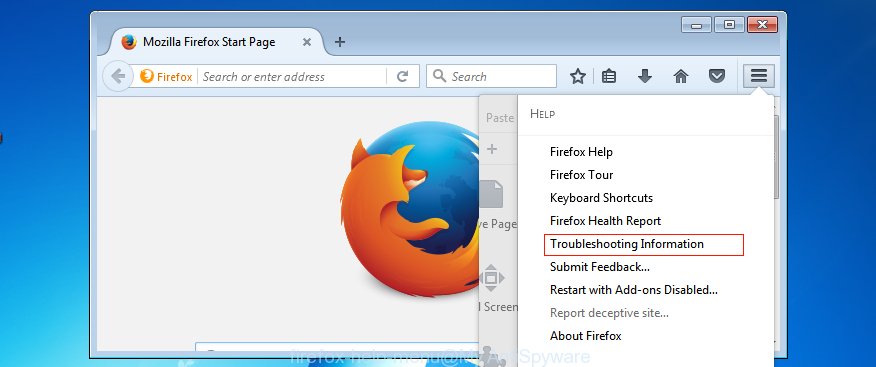
Select the “Troubleshooting information”. If you’re unable to access the Help menu, then type “about:support” in your address bar and press Enter. It bring up the “Troubleshooting Information” page as displayed below.
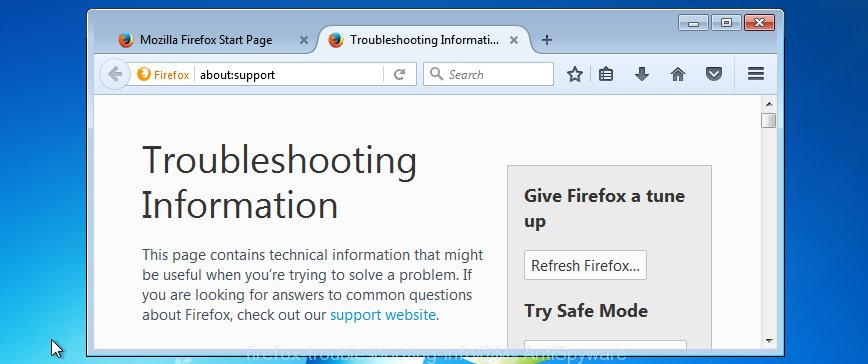
Click the “Refresh Firefox” button at the top right of the Troubleshooting Information page. Select “Refresh Firefox” in the confirmation prompt. The Firefox will begin a procedure to fix your problems that caused by the ad supported software that causes misleading “Your Windows is infected” pop up scam on your web-browser. When, it is finished, click the “Finish” button.
Get rid of “Your Windows is infected” pop up scam from Internet Explorer
In order to restore all internet browser startpage, default search engine and newtab you need to reset the Internet Explorer to the state, that was when the Microsoft Windows was installed on your PC system.
First, run the Internet Explorer, press ![]() ) button. Next, click “Internet Options” as displayed in the figure below.
) button. Next, click “Internet Options” as displayed in the figure below.

In the “Internet Options” screen select the Advanced tab. Next, click Reset button. The Internet Explorer will show the Reset Internet Explorer settings prompt. Select the “Delete personal settings” check box and press Reset button.

You will now need to restart your PC system for the changes to take effect. It will get rid of ad-supported software that displays misleading “Your Windows is infected” fake alerts on your personal computer, disable malicious and ad-supported web-browser’s extensions and restore the IE’s settings like newtab, search engine by default and start page to default state.
Clean up the web browsers shortcuts that have been affected by adware
Important to know, most antimalware software which are able to remove ad supported software that developed to show misleading “Your Windows is infected” pop-up scam within your web-browser, but unable to find out and recover changed shortcuts. So, you need to fix the desktop shortcut files for your Microsoft Edge, Firefox, IE and Chrome web browsers manually.
Open the properties of the web browser shortcut file. Right click on the shortcut of affected internet browser and select the “Properties” option and it will show the properties of the shortcut file. Next, select the “Shortcut” tab and have a look at the Target field as on the image below.
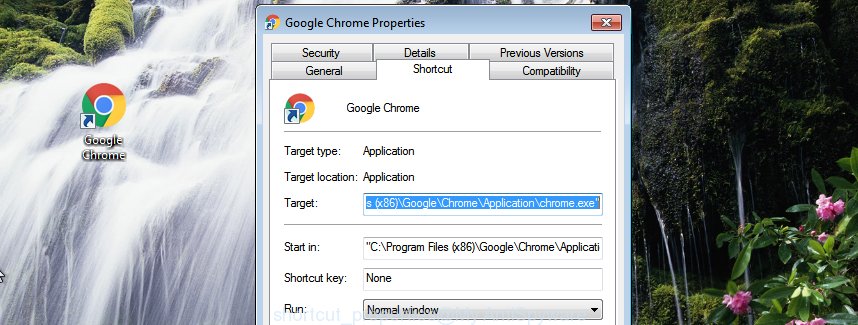
Normally, if the last word in the Target field is chrome.exe, iexplore.exe, firefox.exe. Be sure to pay attention to the extension, should be “exe”! All shortcut files that have been altered by adware that causes misleading “Your Windows is infected” pop-up scam on your browser, usually point to .bat, .cmd or .url files instead of .exe as displayed in the following example

Another variant, an address has been added at the end of the line. In this case the Target field looks like …Application\chrome.exe” http://site.address as shown in the figure below.

In order to fix the infected shortcut, you need to insert right path to the Target field or remove an address (if it has been added at the end). You can use the following information to fix your shortcut files that have been modified by adware that causes browsers to show misleading “Your Windows is infected” fake alerts.
| Google Chrome | C:\Program Files (x86)\Google\Chrome\Application\chrome.exe |
| C:\Program Files\Google\Chrome\Application\chrome.exe | |
| Firefox | C:\Program Files\Mozilla Firefox\firefox.exe |
| Internet Explorer | C:\Program Files (x86)\Internet Explorer\iexplore.exe |
| C:\Program Files\Internet Explorer\iexplore.exe | |
| Opera | C:\Program Files (x86)\Opera\launcher.exe |
| C:\Program Files\Opera\launcher.exe |
Once is done, click OK to save changes. Repeat the step for all web-browsers which are redirected to the “Your Windows is infected” undesired web-page.
Remove “Your Windows is infected” pop up warnings with free programs
If you are not expert at computers, then we recommend to use free removal tools listed below to delete “Your Windows is infected” pop up for good. The automatic method is highly recommended. It has less steps and easier to implement than the manual method. Moreover, it lower risk of system damage. So, the automatic “Your Windows is infected” removal is a better option.
How to automatically remove “Your Windows is infected” pop up scam with Zemana Anti-malware
We advise using the Zemana Anti-malware. You may download and install Zemana Anti-malware to search for and delete “Your Windows is infected” fake alerts from the IE, Mozilla Firefox, Edge and Google Chrome internet browsers. When installed and updated, the malicious software remover will automatically check and detect all threats present on your PC system.

- Visit the page linked below to download Zemana AntiMalware (ZAM). Save it to your Desktop so that you can access the file easily.
Zemana AntiMalware
164810 downloads
Author: Zemana Ltd
Category: Security tools
Update: July 16, 2019
- After the download is complete, close all apps and windows on your personal computer. Open a file location. Double-click on the icon that’s named Zemana.AntiMalware.Setup.
- Further, click Next button and follow the prompts.
- Once installation is complete, click the “Scan” button to begin checking your computer for the adware that causes multiple misleading “Your Windows is infected” alerts and popups. During the scan Zemana will find out threats exist on your personal computer.
- Once the scan get completed, Zemana Anti Malware (ZAM) will prepare a list of unwanted and adware. Once you have selected what you wish to delete from your computer click “Next”. Once the task is done, you can be prompted to restart your system.
Scan and clean your personal computer of adware with HitmanPro
Hitman Pro is a free removal tool which can check your machine for a wide range of security threats such as malware, adwares, PUPs as well as ad supported software that causes misleading “Your Windows is infected” pop up scam on your internet browser. It will perform a deep scan of your personal computer including hard drives and Microsoft Windows registry. When a malware is found, it will help you to remove all found threats from your PC system with a simple click.
Download Hitman Pro on your system by clicking on the link below.
After the download is finished, open the folder in which you saved it. You will see an icon like below.

Double click the HitmanPro desktop icon. Once the tool is started, you will see a screen as shown on the image below.

Further, press “Next” button . Hitman Pro program will scan through the whole PC for the adware which displays misleading “Your Windows is infected” pop up warnings on your PC system. After the system scan is finished, a list of all threats found is produced as displayed below.
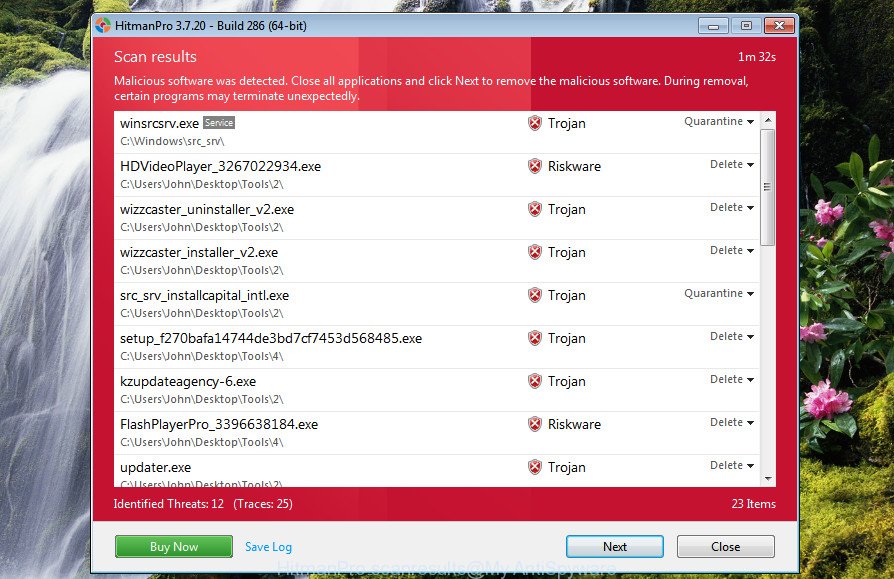
Once you’ve selected what you want to delete from your machine click “Next” button. It will open a prompt, click the “Activate free license” button.
Use Malwarebytes to remove “Your Windows is infected” pop up warnings
We suggest using the Malwarebytes Free that are completely clean your personal computer of the adware. The free utility is an advanced malicious software removal program made by (c) Malwarebytes lab. This application uses the world’s most popular anti-malware technology. It is able to help you get rid of undesired “Your Windows is infected” pop up scam from your browsers, PUPs, malware, browser hijacker infections, toolbars, ransomware and other security threats from your machine for free.
Download MalwareBytes Free from the link below.
327067 downloads
Author: Malwarebytes
Category: Security tools
Update: April 15, 2020
Once the download is finished, close all windows on your computer. Further, run the file named mb3-setup. If the “User Account Control” dialog box pops up like below, press the “Yes” button.
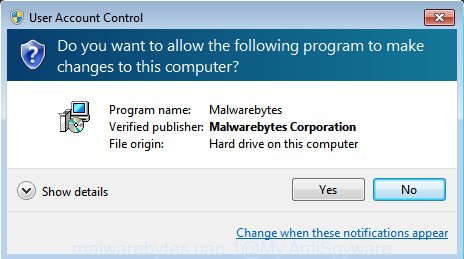
It will open the “Setup wizard” which will allow you set up MalwareBytes AntiMalware on the PC. Follow the prompts and do not make any changes to default settings.
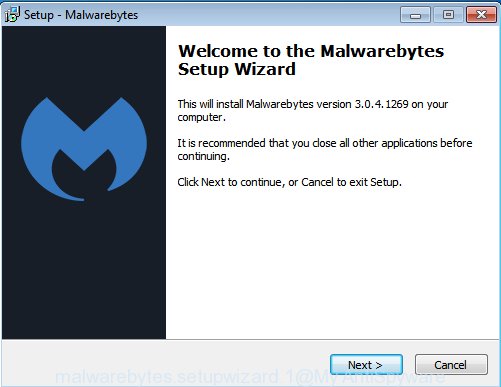
Once setup is done successfully, click Finish button. Then MalwareBytes will automatically run and you can see its main window as displayed on the image below.
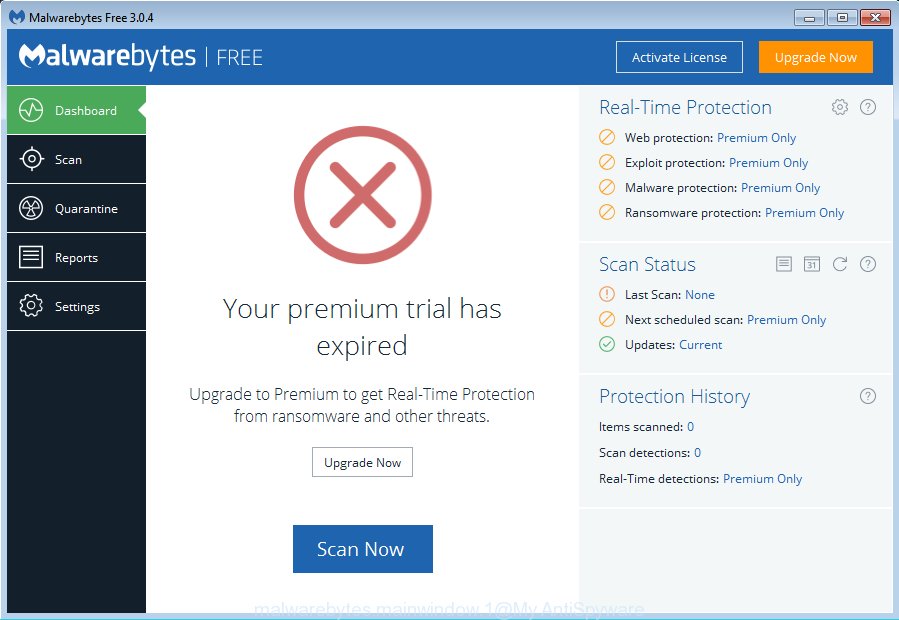
Next, click the “Scan Now” button . MalwareBytes Anti-Malware (MBAM) utility will begin scanning the whole machine to find out adware that shows misleading “Your Windows is infected” fake alerts on your computer. This procedure may take some time, so please be patient. When a threat is found, the number of the security threats will change accordingly.
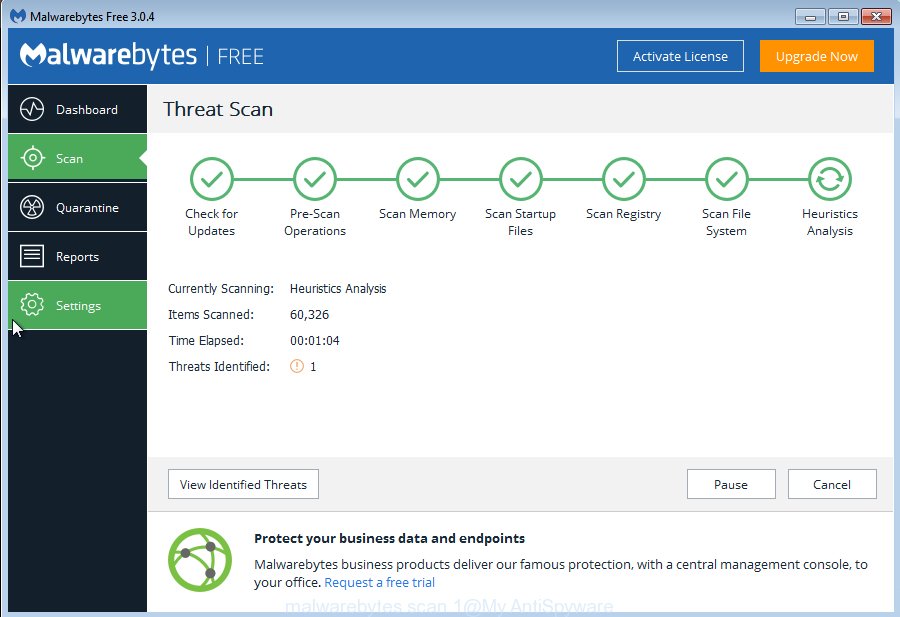
Once the checking is finished, MalwareBytes AntiMalware (MBAM) will display a scan report. You may delete threats (move to Quarantine) by simply click “Quarantine Selected” button.
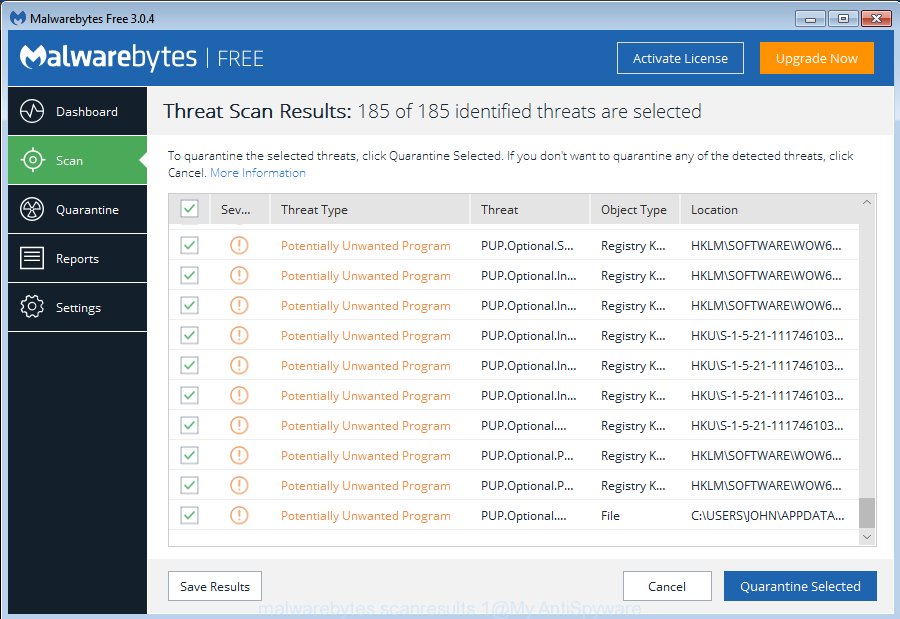
The MalwareBytes Anti Malware (MBAM) will delete adware which created to display misleading “Your Windows is infected” fake alerts within your internet browser and move threats to the program’s quarantine. After the cleaning procedure is done, you can be prompted to restart your computer. We recommend you look at the following video, which completely explains the procedure of using the MalwareBytes Anti Malware to get rid of browser hijackers, adware and other malicious software.
Block “Your Windows is infected” pop up warnings and other unwanted webpages
Run an ad blocker tool such as AdGuard will protect you from harmful advertisements and content. Moreover, you can find that the AdGuard have an option to protect your privacy and stop phishing and spam web sites. Additionally, ad-blocking software will help you to avoid intrusive advertisements and unverified links that also a good way to stay safe online.
Visit the following page to download the latest version of AdGuard for MS Windows. Save it to your Desktop.
26841 downloads
Version: 6.4
Author: © Adguard
Category: Security tools
Update: November 15, 2018
After downloading it, run the downloaded file. You will see the “Setup Wizard” screen as displayed below.

Follow the prompts. When the installation is finished, you will see a window as shown on the screen below.

You can click “Skip” to close the installation program and use the default settings, or press “Get Started” button to see an quick tutorial that will assist you get to know AdGuard better.
In most cases, the default settings are enough and you do not need to change anything. Each time, when you run your computer, AdGuard will run automatically and stop popups, web pages such as “Your Windows is infected”, as well as other harmful or misleading webpages. For an overview of all the features of the program, or to change its settings you can simply double-click on the AdGuard icon, that is located on your desktop.
How to “Your Windows is infected” popup get installed onto personal computer
The adware is bundled with many freeware and commercial software. This PUP can be installed in background without user consent, but usually it’s introduced to a user when a downloaded program are installed. So, read term of use and user agreement very carefully before installing any software or otherwise you can end up with another ad-supported software on your system, like this adware that developed to show misleading “Your Windows is infected” pop-up within your web-browser.
To sum up
Now your PC system should be free of the ‘ad supported’ software which displays misleading “Your Windows is infected” fake alerts on your system. We suggest that you keep Zemana Anti-Malware (to periodically scan your system for new ad supported softwares and other malicious software) and AdGuard (to help you stop undesired pop up advertisements and malicious websites). Moreover, to prevent any adware, please stay clear of unknown and third party apps, make sure that your antivirus program, turn on the option to scan for potentially unwanted software.
If you need more help with “Your Windows is infected” fake alerts related issues, go to our Spyware/Malware removal forum.


















